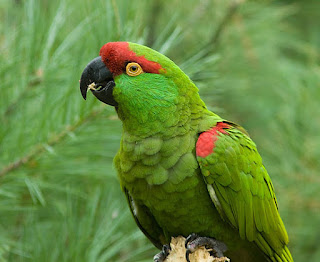ECOLOGY
The
thick-billed parrot is an average sized parrot that has both green and red
coloration. Since this is a medium-sized
parrot, it has been categorized in numerous bird groups such as macaw and
conure. The thick-billed parrot is under
the genus Rhynchopsitta, which only contains
two species, the other species being the maroon-fronted parrot. A
thick-billed parrot’s diet consists of mostly pine seeds and acorns, although
they also consume some juniper berries, agave nectar, insect larvae and conifer
buds. These thick-billed parrots are
known to be very social because they live in large groups and can handle cold
climates. Thick-billed parrots also tend
to fly in V formations when flying long distances. These parrots mate during the beginning of
summer and their eggs are hatched between July and August. Just like most birds, the parents must
provide food and shelter for newborns after they are hatched.
Thick-billed parrot
http://bib.ge/img_animal/23429246tmehnqwervfdcx.jpg
GEOGRAPHY
It is now
only found in Mexico, although it once also occupied areas in the southwestern
United States. The thick-billed parrot usually lives in temperate forests at
high elevation. The first records of
thick-billed parrots in 1941 identified them to have populated northern
Mexico. They also lived in New Mexico
and Arizona up until the 1990s, when they solely occupied northern Mexico.
Map of thick-billed parrot ranges
https://www.defenders.org/sites/default/files/thick-billed-parrot-range-map.jpg
POPULATION
The population of thick-billed parrots, which
has always been somewhat small, is currently endangered and declining due to habitat
destruction. Their total population was
estimated around 4,000 in the early 2000s, although recent surveys have showed
the population to be around 2,800.
LISTING
Thick-billed parrots were listed as endangered on
June 2nd, 1970 in the Southwestern United States, and they
eventually became extinct in this area. Even
though they became extinct in the United States and have been declining in
Mexico for many years, no official recovery plan was made until 2009.
THREATS
The major threat to thick-billed parrots is habitat
destruction for logging. Thick-billed parrots
rely on conifer forests in the Sierra Madre Occidental. Since the thick-billed parrot’s primary
source of food is pine seeds, it needs the pine trees in these conifer forests. The conifer forests in Mexico are decreasing
fairly rapidly, which is causing a rapid loss of food for thick-billed
parrots. There are two minor threats
that contribute to the population decline of thick-billed parrots. The two threats are an abundance of wildfires
that also destroy the conifer forests and the parrots being captured for the illegal
pet trade. Unless changes occur to the
destruction of forests in Mexico, the thick-billed parrots could easily become
extinct.
Deforestation in Mexico
http://www.ecology.com/wp-content/uploads/2012/06/deforestation-mexico-524.jpg
RECOVERY PLAN
The recovery plan created to protect and
restore the populations of thick-billed parrots has five important goals:
1.
Protect existing populations and their habitats
2.
Survey, monitor, and research the population and
habitat
3.
Manage habitat for future thick-billed parrot
population growth
4.
Reduce or eliminate threats, such as illegal pet
trade, timber harvesting, and high intensity fire
5.
Build partnerships and educate the public
With an estimated total cost of recovery at around $6,000, this
recovery plan seems very well organized and thought through The
ultimate goal of this recovery plan is to move thick-billed parrots from the
endangered list to just the threatened list.
The most important step is probably the education of the public, because
the public can provide so much additional benefits. The public can help provide donations, get
involved in the prevention of deforestation, and spread awareness of the
recovery efforts for thick-billed parrots.
WHAT CAN YOU DO?
There are many ways for everyone to help
out thick-billed parrots. This website, http://www.defenders.org/thick-billed-parrot/what-you-can-do,
shows the many steps one could take to support thick-billed parrots. Some of the efforts could include donating,
speaking to others about issues facing these parrots and sending messages to
government leaders.
Works Cited
Lamberski, Nadine, and Susan Healy.
"The Thick-billed Parrot (Rhynchopsitta Pachyrhyncha)."
Journal of Avian Medicine and
Surgery 16.1 (2002): 50-52. Web.
N.p., n.d. Web. <http://www.birdlife.org/datazone/speciesfactsheet.php?id=1584>.
N.p., n.d. Web.
<http://www.defenders.org/thick-billed-parrot/basic-facts>.
N.p., n.d. Web.
<http://www.fws.gov/endangered/species/recovery-plans.html>.















